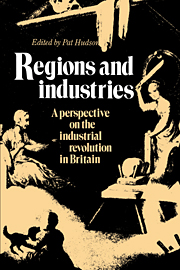Book contents
- Frontmatter
- Contents
- List of figures
- List of maps
- List of tables
- List of contributors
- Acknowledgements
- Introduction
- 1 The regional perspective
- PART ONE THE TEXTILE HEARTLANDS OF THE INDUSTRIAL REVOLUTION
- PART TWO OTHER PATHS, OTHER PATTERNS
- 4 Continuity and change in an industrialising society: the case of the West Midlands industries
- 5 Stages of industrialisation in Cumbria
- 6 The de-industrialisation process: a case study of the Weald, 1600–1850
- 7 Work, culture and resistance to machinery in the West of England woollen industry
- PART THREE THE DIVERSE NATURE OF THE OUTER REGIONS
- Index
5 - Stages of industrialisation in Cumbria
from PART TWO - OTHER PATHS, OTHER PATTERNS
Published online by Cambridge University Press: 05 May 2010
- Frontmatter
- Contents
- List of figures
- List of maps
- List of tables
- List of contributors
- Acknowledgements
- Introduction
- 1 The regional perspective
- PART ONE THE TEXTILE HEARTLANDS OF THE INDUSTRIAL REVOLUTION
- PART TWO OTHER PATHS, OTHER PATTERNS
- 4 Continuity and change in an industrialising society: the case of the West Midlands industries
- 5 Stages of industrialisation in Cumbria
- 6 The de-industrialisation process: a case study of the Weald, 1600–1850
- 7 Work, culture and resistance to machinery in the West of England woollen industry
- PART THREE THE DIVERSE NATURE OF THE OUTER REGIONS
- Index
Summary
Cumbria was undoubtedly one of Britain's recognised textile regions during the late medieval and early modern periods. It had a class of manorial tenants or small yeoman whose activities embraced the main stages of woollen production, and whose work took them into a variety of crafts and small industries. The region also employed water power in such a way as to cause economic historians of a past generation to take it seriously as one of the main seats of an ‘industrial revolution’ in the thirteenth century. However, water power continued to play a significant part in the economic activities of the Cumbrian region until the twentieth century. If we are to write of an industrial transition in Cumbria, it was certainly a long time in the making and, furthermore, the seeds of later deindustrialisation were to some extent sown alongside it. Rural industries became varied and widespread, notably so between the Tudor period and the end of the eighteenth century, but none was powerful enough in its effects to act monocausally on population movements (save, briefly, the copper mining of the late sixteenth century), and none can be easily identified as having stimulated major social transformations. The north and west of the region certainly experienced some major industrial developments in the nineteenth century, but their leading sectors (cotton, coal and steel) bore little direct or organic relationship to the earlier, more widely diffused industries of the Cumbrian land-mass as a whole. Accordingly, the proto-industrialisation concept is hard to apply to the region.
- Type
- Chapter
- Information
- Regions and IndustriesA Perspective on the Industrial Revolution in Britain, pp. 132 - 155Publisher: Cambridge University PressPrint publication year: 1989
- 1
- Cited by



